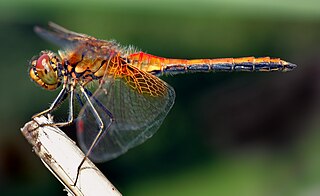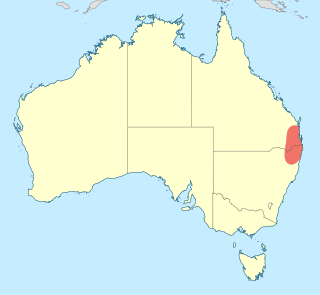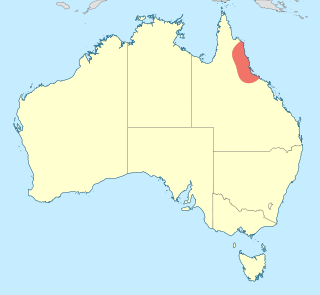Related Research Articles

Odonata is an order of flying insects that includes the dragonflies and damselflies. Members of the group first appeared during the Triassic, though members of their total group, Odonatoptera, first appeared in Late Carboniferous.

A dragonfly is a flying insect belonging to the infraorder Anisoptera below the order Odonata. About 3,000 extant species of true dragonfly are known. Most are tropical, with fewer species in temperate regions. Loss of wetland habitat threatens dragonfly populations around the world. Adult dragonflies are characterized by a pair of large, multifaceted compound eyes, two pairs of strong, transparent wings, sometimes with coloured patches, and an elongated body. Many dragonflies have brilliant iridescent or metallic colours produced by structural colouration, making them conspicuous in flight. An adult dragonfly's compound eyes have nearly 24,000 ommatidia each.

The insect family Macromiidae contains the dragonfly species known as cruisers or skimmers. They tend to fly over bodies of water straight down the middle. They are similar to Aeshnidae in size, but the eyes are green and just barely meet at the top of the head.

Somatochlora, or the striped emeralds, is a genus of dragonflies in the family Corduliidae with 42 described species found across the Northern Hemisphere.

Macromidia is a genus of dragonfly in family Synthemistidae, which is earlier treated as a subfamily of Corduliidae. According to World Odonata List, this genera is best considered incertae sedis. It contains the following species:

Somatochlora sahlbergi, the treeline emerald, is a species of dragonfly in the family Corduliidae. It is found at high latitudes across northern Eurasia and North America, and occurs farther north than any other dragonfly.

The Synthemistidae are the family of dragonflies commonly known as tigertails, or sometimes called southern emeralds. This family is sometimes treated as a subfamily of Corduliidae. This is an ancient dragonfly family, with some species occurring in Australia and New Guinea. Most species are small in size and have narrow abdomens. Their nymphs are bottom dwellers, and resist droughts by burying themselves very deeply. Synthemistid dragonflies frequently prefer marshy areas, as well as fast-flowing streams. The family Synthemistidae is sometimes called Synthemidae.

The brilliant emerald, Somatochlora metallica, is a middle-sized species of dragonfly. It is the largest and greenest of the Somatochlora species; 50–55 millimetres (2.0–2.2 in) long.

Libelluloidea is a superfamily of dragonflies.

The tau emerald is a species of dragonfly in the family Corduliidae. Corduliidae is the only family not a clade within the Infraorder Anisoptera. The species was first described by Edmond de Sélys Longchamps in 1871.

Hemicordulia koomina is a species of dragonfly in the family Corduliidae, known as the Pilbara emerald. It has been found in the Pilbara region of Western Australia.

Macromidia donaldi is a species of dragonfly in the family Synthemistidae. It is known only from the Western Ghats of India and from Sri Lanka.

Apocordulia is a genus of dragonflies in the family Austrocorduliidae, endemic to the Murray-Darling Basin in eastern Australia.

Austrocordulia territoria is a species of dragonfly in the family Austrocorduliidae, commonly known as the Top End hawk. It is a medium-sized, black and yellow dragonfly, endemic to coastal Northern Territory, Australia, where it inhabits streams.

Micromidia convergens is a species of dragonfly in the family Austrocorduliidae, known as the early mosquitohawk. It is a small to medium-sized, black to metallic green dragonfly with pale markings on its abdomen. It is endemic to eastern Australia, where it inhabits rainforest streams.

Archaeophya magnifica is a species of dragonfly in the family Gomphomacromiidae, known as the magnificent urfly. It is a large, metallic-black dragonfly with yellow markings and clear wings. It is endemic to north-east Queensland, Australia. where it inhabits rainforest streams.

The Eurasian baskettail is a species of dragonfly. It was described by Toussaint de Charpentier in 1825 and initially placed in the genus Libellula. It is the type species of the genus Epitheca.
Somatochlora daviesi is a species of dragonfly in the family Corduliidae. It was first described in 1977 based on specimens from Meghalaya, India, and is also known from Nepal and Bhutan. It resembles the east Asian S. dido in its small size and lack of yellow markings on most of the abdomen. Like other species in the genus, S. davisi is predominantly dark metallic brown to green. The formerly recognised Somatochlora nepalensis is now considered to be a synonym of S. daviesi.
Hemicordulia hilaris is a species of Pacific dragonfly in the family Corduliidae, first described by the Dutch entomologist Maurits Lieftinck in 1975. The species is found across the Pacific Islands including Samoa and New Caledonia, with its range extending east to the Cook Islands and French Polynesia.
Lauromacromia is a genus of dragonfly in the family Corduliidae, which are found in South America. The genus has been created in 1970 by Dirk Geijskes.
References
- ↑ Dijkstra, Klaas-Douwe B.; Kisakye, John Joseph (2004). "Idomacromia jillianae sp. nov. from Uganda (Odonata: Corduliidae)". International Journal of Odonatology. 7 (3): 459–466. doi:10.1080/13887890.2004.9748231. S2CID 53314397 . Retrieved 2022-12-01.
- ↑ Fleck, G.; Ullrich, B.; Brenk, M.; Wallnisch, C.; Orland, M.; Bleidissel, S.; Misof, B. (9 October 2008). "A phylogeny of anisopterous dragonflies (Insecta, Odonata) using mtRNA genes and mixed nucleotide/doublet models". Journal of Zoological Systematics and Evolutionary Research . 46 (4): 310–322. doi:10.1111/j.1439-0469.2008.00474.x.